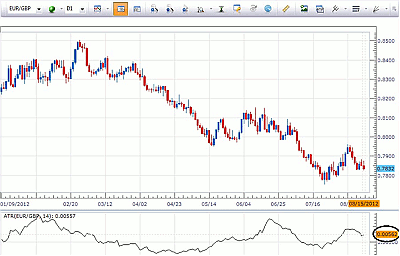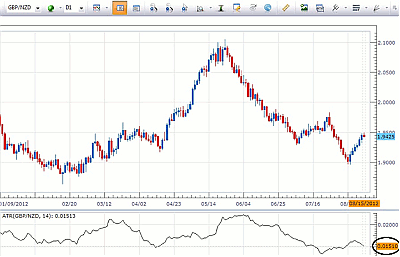Richard Krivo of DailyFX.com explains how smart currency traders set stop losses that keep your risk low but are unlikely to be hit.
Often, traders will simply select an arbitrary number for the stop that they will use on each and every trade.
Some traders are fond of saying something like, “I always place my stop (insert any random number here) pips from my entry.” While that might make things easy when determining stop placement, it makes no sense relative to how a specific currency pair has been moving.
Consider volatility, for example. A 100-pip stop on the EUR/GBP is not the same as using a 100-pip stop on the GBP/NZD. The volatility of the two pairs is quite different, and can also change from week to week. So we need to find a tool that gives us a way to quantify the current market environment in each currency pair to determine our stop level.
One such tool is the Average True Range, or ATR. A simplified explanation of the ATR is that it measures the range of a trading session in pips and then determines the average range for a certain number of sessions.
For instance, if we are using a daily chart with a default value of 14, the ATR will measure the average daily range, from high to low of the previous 14 days. This way you are getting a current reading on the volatility of a specific currency pair.
Let’s get more detailed and consult the charts below...
The current 14-day ATR for the EUR/GBP is about 56 pips, while the same 14 day ATR for the GBP/NZD is almost three times that amount—about 151 pips. So we can see why a standard 100-pip stop is not the best way to determine your risk on every trade.
Many traders will simply use the ATR to identify their risk, as seen on these charts.
In the case of trading the EUR/GBP, they would place their stop 56 pips from their entry, while in the case of the GBP/NZD their stop would be placed 151 pips from their entry. (When going long, the stop would go below the entry, and when going short the stop would go above the entry.)
Using this method tends to “customize” the stop placement to a specific currency pair and the market conditions currently in place.
While there are other ways to determine stop placement, this is one way to base your risk on the reality of the market you are trading. This additional step can increase the chance of having a successful trade.
Richard Krivo can be found at DailyFX.com.












